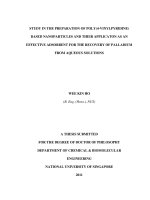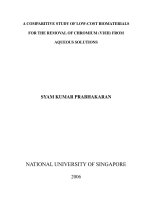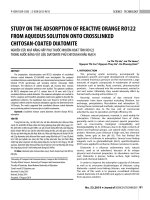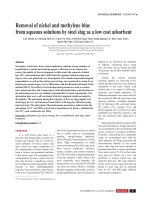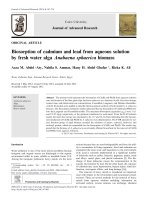Preparation of chitosan/poly vinyl alcohol hydrogel crosslinked by glyoxal towards applications in the removal of copper (II) ions from aqueous solutions
Bạn đang xem bản rút gọn của tài liệu. Xem và tải ngay bản đầy đủ của tài liệu tại đây (789.76 KB, 7 trang )
TNU Journal of Science and Technology
227(15): 93 - 99
PREPARATION OF CHITOSAN/POLY VINYL ALCOHOL HYDROGEL
CROSSLINKED BY GLYOXAL TOWARDS APPLICATIONS IN THE
REMOVAL OF COPPER (II) IONS FROM AQUEOUS SOLUTIONS
Bui Thi Thao Nguyen*, Nguyen Nhi Tru, Ha Thi Tram Anh,
Nguyen Thi Quynh Giao, Huynh Thi Ngoc Han
Ho Chi Minh City University of Technology - Vietnam National University Ho Chi Minh
ARTICLE INFO
Received:
06/9/2022
Revised:
10/10/2022
Published:
11/10/2022
KEYWORDS
Composite hydrogel
Chitosan
PVA
Glyoxal
Copper ion
ABSTRACT
Recently, hydrogels have been utilized as effective adsorbents to
remove heavy metal ions from aqueous solutions. In this study, the
composite hydrogels based on chitosan and poly vinyl alcohol (PVA)
crosslinked by glyoxal were conducted towards the application of
removing copper ions from water. The specific functional groups of
chitosan and PVA molecules were revealed by Infrared spectroscopy
(FTIR). The swelling property of the composite was investigated and
had the highest value of 850%. In addition, the ability of hydrogel to
remove copper ions from aqueous solution was evaluated through the
experiments supported by UV vis equipment. The Langmuir and
Freundlich isotherm model could fit the data of the experiment. And
the hydrogel with 10%wt glyoxal had maximum copper ion absorption
with 183 mg.g-1 at pH 7.
NGHIÊN CỨU CHẾ TẠO HYDROGEL TỪ CHITOSAN VÀ POLY VINYL
ALCOHOL VỚI CHẤT ĐÓNG RẮN GLYOXAL HƯỚNG ĐẾN ỨNG DỤNG
LOẠI BỎ ION ĐỒNG TRONG NƯỚC
Bùi Thị Thảo Nguyên*, Nguyễn Nhị Trự, Hà Thị Trâm Anh,
Nguyễn Thị Quỳnh Giao, Huỳnh Thị Ngọc Hân
Trường Đại học Bách khoa – Đại học Quốc gia Thành phố Hồ Chí Minh
THƠNG TIN BÀI BÁO
Ngày nhận bài:
06/9/2022
Ngày hồn thiện: 10/10/2022
Ngày đăng: 11/10/2022
TỪ KHĨA
Composite hydrogel
Chitosan
PVA
Glyoxal
Ion đồng
TÓM TẮT
Gần đây, hydrogel được dùng phổ biến làm chất hấp phụ hiệu quả để
loại bỏ các ion kim loại nặng khỏi dung dịch nước thải. Trong nghiên
cứu này, các hydrogel được tổng hợp dựa trên chitosan và poly vinyl
alcohol (PVA) được liên kết ngang bởi glyoxal đã được tiến hành theo
hướng ứng dụng loại bỏ các ion đồng khỏi nước thải. Các nhóm chức
đặc trưng của phân tử chitosan và PVA được khảo sát bằng quang phổ
hồng ngoại (FTIR). Tính chất trương nở của composite cũng được
nghiên cứu và đạt kết quả 850%. Ngoài ra, khả năng loại bỏ các ion
đồng ra khỏi nước thải của hydrogel đã được đánh giá thơng qua các thí
nghiệm với thiết bị UV vis. Mơ hình đẳng nhiệt Langmuir và
Freundlich được sử dụng để đánh giá khả năng hấp phụ của hydrogel và
dữ liệu của thí nghiệm khớp với mơ hình. Hydrogel được tổng hợp với
10% glyoxal có khả năng hấp thụ ion đồng với độ hấp phụ 183 mg.g-1 ở
môi trường trung tính.
DOI: />*
Corresponding author. Email:
93
Email:
TNU Journal of Science and Technology
227(15): 93 - 99
1. Introduction
Nowadays, water pollution becomes a serious problem of mankind. Polluted water can also
lead to numerous health conditions. Especially, the residue of heavy metals causes a poor impact
on human health, leading to transmission of diseases such as cholera, diarrhea, and dysentery.
Many methods of heavy metal treatment in wastewater have been studied and applied such as
biochemical method, physicochemical method, chemical precipitation method, ion exchange,
flotation, and electrochemical deposition. However, most of the above methods are expensive.
Hydrogel technology is outstanding treatment methods with high adsorption efficiency, energy
saving, and low operating costs based on the processes of adsorption of hydrogel [1].
Among bio-adsorbent materials, chitosan is a natural, non-toxic, hydrophilic, biocompatible,
and biodegradable agent. Moreover, chitosan is a kind of cheap raw material with high metal
adsorption capacity. Being another adsorbent material, poly vinyl alcohol (PVA) is a watersoluble polymer with functional chemical groups which can interact with other polymers to form
hydrogel. PVA hydrogel possesses numerous advantages such as biodegradation, biocompatible,
and high degree of swelling in water [2], [3]. In PVA - chitosan (PVA/CS) hydrogel crosslinked
with glyoxal, PVA contributes to increase mechanical property and swelling behavior. In
addition, glyoxal crosslinker is used to link polymer chains, contributing to enhancing hydrogel
strength by forming network from PVA and chitosan molecules [4], [5]. Consequently, polymer
hydrogels based on PVA and chitosan are candidates for a range of application in environmental
fields, especially water treatment based on adsorption properties of PVA and chitosan through
various scientific researches [6], [7].
In this study, the hydrogels based on PVA and chitosan were synthesized and investigated
their properties. Particularly, the effect of curing agent on the hydrogel properties was researched
in order to produce the hydrogel with high applicability of wastewater treatment. Moreover, other
analytical methods were used to evaluate hydrogel properties, including infrared spectroscopy
(FTIR) and UV-vis spectroscopy.
2. Materials and Methods
2.1. Materials
PVA (average Mw = 205 000 g.mol-1, 98-99% hydrolyzed) and chitosan (average Mw = 5000
g/mol) were purchased from Sigma Aldrich (Germany). Glyoxal was obtained from Wako
Chemical Industries, Japan. Other chemicals with 99% purity were distributed by Guangdong
Guanghua Sci-Tech Company (China).
2.2. Preparation of PVA-chitosan hydrogel composite
Firstly, PVA solution 8 wt% and chitosan solution 5 wt% were prepared respectively by
adding PVA into distilled water and chitosan into acetic acid solution 0.5 M. Next, PVA and
chitosan solution were poured sequentially into reaction flask. The experiment was conducted at
60oC with a stirring time of 180 minutes to get homogenous mixture. After that, glyoxal was put
into the reacted solution. The solution was continually stirred to get homogenous dispersion at
constant temperature 60 oC.
Then proper weight of the mixture was put in glass Petri dish, followed by being cured at 80oC
for 90 minutes in an oven. After that, the sample was dried at 60oC and stored in a desiccator.
The weight percentage of chitosan in the composite hydrogel was 30 wt% and the weight
percentage of glyoxal was investigated with 10, 15 and 20 wt% and the samples were named as
S10, S15, S20 respectively.
94
Email:
227(15): 93 - 99
TNU Journal of Science and Technology
2.3. Measurements
2.3.1. Fourier Transform Infrared Spectroscopy (FTIR)
The functional groups of PVA and lignin molecules were investigated by Frontier FT-IR/NIR
instrument model at Institute of Applied Materials Science, Ho Chi Minh City, Vietnam. The
scan range is 4000-450 cm -1, the scan speed is 0.2 mm/s.
2.3.2. Swelling behavior test
The composite hydrogel samples were dried and weighed (Wo), then were put into distilled
water for 24 h to equilibrium swelling weight (Ws) for removing soluble parts from the hydrogel.
Next, the hydrogel was dried at 60oC in an oven.
Then, the samples were cut into 2 x 2 cm piece and weighed (We). Next, the dried samples
were soaked in distilled water at 33oC. After that, the samples shall be removed from the water
one at a time, all surface water was wiped off with a dry cloth, then weighed (Ws) immediately
(ASTM D 570 – 98). The formulations of calculating the water uptake (swelling ratio) was
shown below [8]:
Water uptake (swelling ratio _ SR %) = [(Ws – We)/We] x 100
(1)
2.3.3. Adsorption experiments
a) Adsorption calculation
The adsorption equilibrium experiments were conducted with the initial concentration (Co) of
Cu (II) ranged from 30 to 220 mg.L-1. Hydrogel was weighed and soaked in Cu (II) solutions with
different initial concentration under stirring at room temperature for 24 h. After adsorption process,
the Cu (II) concentrations (C) were determined through the relationship between the absorbance
and concentration of colored solutions. The absorbance of CuSO4 solution was determined at a
wavelength of 635 nm by UV-Vis spectrophotometer (UV/UV-NIR Horiba Dual-FL). The amount
of adsorption q (mg.g-1) was calculated using the equation (2) below [9], [10]:
(
)
(2)
Where C0 and C (mg.L ) were the initial and equilibrium concentration of the copper
solution, and V (L) is the volume of the Cu(II) solution, and m (g) is the weight of the dried
adsorbent hydrogel.
-1
b) Equilibrium Isotherms Study
To evaluate Cu (II) absorbing ability of the hydrogel, the adsorption process with various
initial concentrations was investigated with Langmuir isotherm (3) and Freundlich isotherm (4)
models [11].
(3)
lnq = lnC + lnK.
(4)
-1
where (mg.g ) was the maximum adsorption capacity, k (L.mg ) was a Langmuir constant
related to the adsorption energy, K (mg.g-1) was a Freundlich constants related to absorption
capacity of adsorbent material, and 1/n was the Freundlich coefficient relative heterogeneity.
-1
3. Results and discussion
3.1. Investigating characteristic functional groups of the composites
The FTIR spectrum of PVA was shown in Figure 1. It can be seen that the absorption peak at
3282 cm-1 was specific for hydroxyl group. The sharp peak at 2919 cm-1 was related to the
prolonged vibration of the –CH2 group. Peaks 1720 and 1085 cm-1 referred C = O and C - O
95
Email:
TNU Journal of Science and Technology
227(15): 93 - 99
stretching from the acetate group remaining from PVA. Absorption peaks from 1423 cm-1
revealed C–H bending of the –CH2 group. Peaks 835 cm-1 reflected C-C stretching vibration.
Similar peaks were discovered for the crosslinked PVA - chitosan samples. Due to the
interaction between groups of both chitosan and PVA, the peak referring to the vibration of
hydroxyl groups was 3689 cm-1 whereas the peak was 3282 cm-1 in PVA sample. In addition, a new
peak located at 3319 cm-1 appeared in chitosan-PVA hydrogel due to the NH2 vibration of chitosan.
Figure 1. FTIR spectra of PVA and crosslinked PVA-chitosan
3.2. Investigating swelling behavior
Figure 2. The shape of the hydrogel before (a) and after (b) swelling test
Within swelling test, the hydrogel absorbed water and increased the hydrogel volume (Figure
2). The hydrogel became light brown compared to original sample.
Considering various samples with glyoxal ratio separately, from Figure 3, the S10 hydrogel
had about 850% swelling ratio (SR) which is the highest water absorption and swelling capacity
compared to other hydrogels. Whereas the S15 hydrogel sample showed lower water swelling
results about 550% SR. It could be explained that the higher glyoxal ratio contributed to
increasing the crosslinking density, which reduced the -OH group content in the sample, leading
to a decrease in the water swelling capacity of S15. And S20 sample with the highest glyoxal
content possessed the lowest water swelling about 400% SR. Compared to chitosan/Poly (Vinyl
Alcohol) blended films with degree of swelling for the blended films about 1047% and poly
(vinyl alcohol) and chitosan hydrogel prepared by UV irradiation with swelling ratio about 350%
in some previous research [12], [13], the crosslinked PVA chitosan hydrogels had remarkable
swelling degree ranging from 400% to 850%.
96
Email:
TNU Journal of Science and Technology
227(15): 93 - 99
Figure 3. Swelling ratio of the hydrogel samples
3.3. Cu (II) isothermal adsorption
The equilibrium isotherm is used to investigate the properties of the adsorbent [10], [11]. In
this study, the Cu (II) adsorption isotherms of PVA/chitosan hydrogel were measured at 30 ◦C and
pH 7, which were presented in Figure 5.
From table 1, the Cu (II) ions inserted to hydrogel increased linearly with the initial
concentrations of Cu (II) increasing. When initial concentration was from 30 (mg.l -1) to 220
(mg.l-1), the amount of Cu(II) ions adsorbed increased from 19.429 (mg.g-1) to 92.841 (mg.g-1)
(Table 1).
Table 1. The adsorption amount q of S10
hydrogel
Co (mg.l-1)
220
170
120
90
60
30
C (mg.l-1)
176.674
133.002
89.634
66.356
42.643
20.933
(mg.g-1)
92.841
79.281
65.070
50.666
37.194
19.429
Figure 4. The effect of equilibrium Cu (II) ion
concentration on the adsorption amount of S10 hydrogel
It could be seen from Figure 4 that the Cu (II) ion adsorption depended on the moving of Cu
(II) ions from the solution to the surfaces of the hydrogels. At increasing initial concentrations of
Cu (II) solution, the adsorption on the surfaces of the hydrogel increased to equilibrium [9]. The
equilibrium adsorption had been investigated by isotherm models, including Langmuir and
Freundlich.
Figure 5a presented the relationship between lnq and lnC, following Freundlich model. Figure
5b illustrated the relationship between q and C, following Langmuir model. The parameters were
revealed in Table 2.
According to Table 2, the correlation coefficients (R2) of the linear form for Langmuir model
were much closer to 1.0 than that of Freundlich models (Figure 5). According to Langmuir
model, the maximum Cu (II) uptakes of the hydrogel were drawn from Langmuir model as
shown in Table 2. From the Figure 5b, it was found that the Langmuir curve fitted the
experimental parameters. Langmuir curve proved that Langmuir model described properly the Cu
97
Email:
TNU Journal of Science and Technology
227(15): 93 - 99
(II) adsorption by hydrogel adsorbents, revealing the monolayer adsorption of Cu (II) ions on the
surface of the hydrogel. Compared to polyvinyl alcohol/chitosan/graphene oxide hydrogel with
maximum Cu (II) adsorption capacities about 162 mg.g−1 [14] and cross-linked chitosan-PVA
spherical hydrogel with maximum adsorption capacity for Cu(II) about 62.1 mg.g-1 [15], the
PVA/chitosan hydrogel sample had the Cu (II) adsorption capacity varying from 19.429 (mg.g -1)
to 92.841 (mg.g-1) (Table 1) and the maximum adsorption capacity with 183.486 (mg.g-1) (Table
2) according to Langmuir Isotherm.
Table 2. The isotherm parameters of Langmuir and Freundlich models
-1
(mg.g )
183.486
Langmuir Isotherm
b (l/mg)
R2
0.00583
0.99236
RL
0.438
Freundlich Isotherm
1/n
K
R2
0.73131
2.264
0.98754
Figure 5. Adsorption isotherms of Cu (II) on the hydrogel, (a) Freundlich model and (b) Langmuir model
A dimensionless separation coefficient, RL, which helped to further discovery on adsorption
process based on Langmuir model, can be calculated from the equation (5) below [11]:
(5)
The favorable value of RL was about (0 < RL < 1), which gave a good indication on affinity
between the adsorbent and the adsorbate. According to the Table 2, the RL value for the hydrogel
was smaller than 1.0, showing a good adsorption for Cu (II) ions.
4. Conclusion
In this study, the hydrogel based on PVA and chitosan was fabricated successfully. The FTIR
spectra showed that the hydrogel had functional groups of PVA and chitosan. By investigating
the effect of the glyoxal crosslinker content to the water swelling behavior of the hydrogel, the
adsorbents showed the highest swelling ratio about 850% when using 10% glyoxal. In the copper
ion adsorption experiment, the Langmuir and Freundlich isotherm models were using to evaluate
the copper ion adsorption capacity. The maximum copper ion adsorption of the hydrogel was
183.486 mg/g. This reveals that the hydrogel based on PVA and chitosan could remove copper
ion from the wastewater with the high adsorption capacity.
Acknowledgements
We acknowledge the technical support from the Faculty of Materials Technology, Ho Chi
Minh City University of Technology (HCMUT), VNUHCM for this study.
98
Email:
TNU Journal of Science and Technology
227(15): 93 - 99
REFERENCES
[1] E.-R. Kenawy, E. A. Kamoun, M. S. M. Eldin, and M. A. El-Meligy, “Physically crosslinked
poly(vinyl alcohol)- hydroxyethyl starch blend hydrogel membranes: Synthesis and characterization for
biomedical applications,” Arabian Journal of Chemistry, vol. 7, pp. 372-380, 2014.
[2] S. J. Buwalda, K. W. Boere, P. J. Dijkstra, J. Feijen, T. Vermonden, and W. E. Hennink, “Hydrogels in
a historical perspective: From simple networks to smart materials,” Journal of Controlled Release, vol.
190, pp. 254-273, 2014.
[3] S. C. Lee, I. K. Kwon, and K. Park, “Hydrogels for delivery of bioactive agents: A historical
perspective,” Adv. Drug Deliv. Rev, vol. 65, pp. 17-20, 2013.
[4] A. Chetouani, M. Elkolli, M. Bounekhel, and D. Benachour, “Chitosan/oxidized pectin/PVA blend
film: mechanical and biological properties,” Polym. Bull., vol. 74, pp. 4297-4310, 2017.
[5] Y. Zhang, P. C. Zhu, and D. Edgren, “Crosslinking Reaction Of Poly(Vinyl Alcohol) With Glyoxal,”
Journal of Polymer Research, vol. 17, pp. 725-730, 2010.
[6] Z. Abdeen, S. G. Mohammad, and M. S. Mahmoud, “Adsorption of Mn (II) ion on polyvinyl
alcohol/chitosan dry blendingfrom aqueous solution,” Environmental Nanotechnology, Monitoring
&Managemen, vol. 3, pp. 1-9, 2015.
[7] E. A. Kamoun, X. Chen, M. S. M. Eldin, and E.-R. S. Kenawy, “Crosslinked poly(vinyl alcohol)
hydrogels for wound dressing applications: A review of remarkably blended polymers,” Arabian
Journal of Chemistry, vol. 8, pp. 1-14, 2015.
[8] T. Jamnongkan and K. Singcharoen, “Towards novel adsorbents: the ratio of PVA/chitosan blended
hydrogels on the copper (II) ion adsorption,” Energy Procedia, vol. 89, pp. 299-306, 2016.
[9] E. Yan, M. Cao, J. Jiang, J. Gao, C. Jiang, X. Ba, X. Yang, and D. Zhang, “A novel adsorbent based on
magnetic Fe3O4 contained polyvinyl alcohol/chitosan composite nanofibers for chromium (Ⅵ)
removal,” Solid State Sciences, vol. 72, pp. 94-102, 2017.
[10] S. K. Vineeth, R. V. Gadhave, and P. T. Gadekar, “Glyoxal Cross-Linked Polyvinyl Alcohol
Microcrystalline Cellulose Blend as a Wood Adhesive with Enhanced Mechanical, Thermal and
Performance Properties,” Mat. Int., vol. 2, pp. 0277-0285, 2020.
[11] J. Chedly, S. Soares, A. Montembault, Y. von Boxberg, M. Veron-Ravaille, C. Mouffle, M.-N.
Benassy, J. Taxi, L. David, and F. Nothiaset, “Physical chitosan micro hydrogels as scaffolds for spinal
cord injury restoration and axon regeneration,” Biomaterials, vol. 138, pp. 91-107, 2017.
[12] E. A. El-Hefian, M. M. Nasef, and A. H. Yahaya, “The Preparation and Characterization of Chitosan/
Poly (Vinyl Alcohol) Blended Films,” E-Journal of Chemistry, vol. 7, pp. 1212-1219, 2010.
[13] S. J. Kim, S. J. Park, and S. I. Kim, “Swelling behavior of interpenetrating polymer network hydrogels
composed of poly(vinyl alcohol) and chitosan,” Reactive & Functional Polymers, vol. 55, pp. 53–59,
2003.
[14] L. Li, Z. Wang, P. Ma, H. Bai, W. Dong, and M. Chen, “Preparation of polyvinyl alcohol/chitosan
hydrogel compounded with graphene oxide to enhance the adsorption properties for Cu(II) in aqueous
solution,” Journal of Polymer Research, vol. 22, pp. 150-160, 2015.
[15] Q. Song, J. Gao, Y. Lin, Z. Zhang, and Y. Xiang, “Synthesis of cross-linking chitosan-PVA composite
hydrogel and adsorption of Cu(II) ions,” Water Science & Technology, vol. 81, pp. 1063–1070, 2020.
99
Email:




